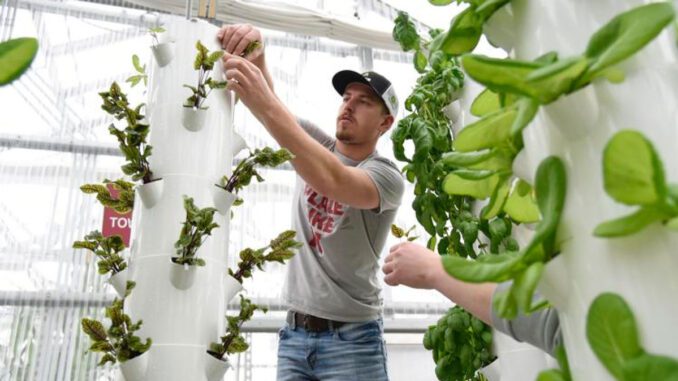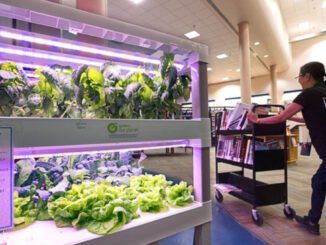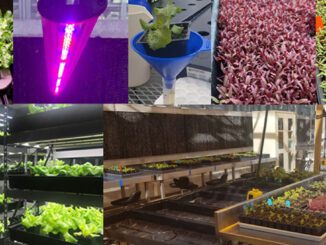
PROGRESS: Morningside Agriculture program quickly growing
Ag Food Program Growing | Caitlin Yamada |
SIOUX CITY – The Morningside University Regina Roth Applied Agriculture and Food Studies Program has grown significantly since its inception in 2015, providing students with more opportunities for unique and hands-on learning.
To expand the program further, the private Sioux City university purchased 76 acres of farmland at auction for about $1.3 million and built a state-of-the-art greenhouse and adjacent outdoor classroom at a price of $1.2 million.
The university also recently received $51,500 from Cargill for new equipment.
Serving around 90 students a year, the program is one of Morningside’s fastest-growing majors. It offers courses in agriculture and food studies, and agriculture education, as well as minors in agriculture communication, agriculture studies, agribusiness, environmental policy, agronomy and food safety.
The program started in 2015 with just nine students, a conference room in Buhler Rohlfs Hall and an externship program to place students in the community, said Department Head Tom Paulsen.
At that time, Morningside President John Reynders said the college was uniquely positioned to offer a program of study related to agriculture and food because of its location in one of the world’s major agricultural regions.
“So many students at Morningside come from communities that are anchored in ag-related industries,” Reynders said. “And they grow up with a passion, an understanding and an appreciation for the value of this industry. Then there is Sioux City’s long history of serving as the regional center for a wide range of companies and businesses devoted to agriculture and related support services.”
Before launching the program, Morningside offered an agribusiness major with a livestock marketing emphasis that was closely tied to the former Sioux City stockyards. But that academic program had ended nearly 20 years ago at the time.
“When we were looking for new programs that would allow our students to go off and flourish and make differences in the world, something related to agriculture and food production seemed like a natural fit,” Reynders said in 2014.
The ag teacher education major, added in 2018, trains students to be middle and high school agriculture teachers, allowing students to learn the skills to be teachers, as well as agriculture skills. Morningside was just the third college in Iowa to offer a major in agriculture education.
Most agriculture programs are found at large public universities, like Iowa State University. It’s rare for a small college to employ professors whose full-time job is to teach courses in agriculture, according to Paulsen. He said Morningside is a unique option for students who want the small-college experience.
The program has partnered with the Sioux City Career Academy to teach high school students about agriculture while teaching the college students instructional skills.
The Morningside garden to table experience
The Morningside garden program started in the fall 2017 in a history of food and agriculture class taught by Paulsen.
Students in the class liked the idea of a garden that could be used for both in-class study and co-curricular activities. The garden would provide fresh produce for the college dining hall and for local food banks, and it would be used to educate children and other community members about gardening best practices.
The college was awarded a $10,000 matching grant from The Wellmark Foundation.
Nearly 90 students contributed 270 hours of labor to transform the grassy lot across the street from Buhler Rohlfs Hall into a garden with in-ground beds, raised beds, pollinator gardens and a shed. The two raised beds closest to the street were made in the shape of an “M” and a “C.”
Since then, the program has added a retaining wall, expanded the in-ground beds and raised beds, built a gazebo and added a storage shed. Last year, the program changed the bed shaped like a “C” to a “U” in honor of the school changing from a college to a university.
The program produces around 1,600 pounds to 1,800 pounds a year, Paulsen said. Last year the students grew around 1,700 pounds of produce.
The Lags Greenhouse
Last year, Morningside completed a 3,300 square-foot greenhouse on the 2.5-acre site of the former Longfellow Elementary school located on campus.
The greenhouse provides laboratory and teaching space for students. The greenhouse is separated into four different areas:
– A head house for preparation and storage;
– Aquaponics room for fish and other aquatic production;
– A grow tower/leafy greens room for the production of food quality greens and;
– A warm production house room capable of producing crops with two separate climate requirements.
The new greenhouse started construction in April 2021 and the first seeds were planted on Jan. 13, Paulsen said.
Morningside senior Gage Dewsbury has been working on the aquaponics aspect of the greenhouse. To grow the plants, fish are used to produce ammonia, which is transformed into nitrates, which helps the plants grow without soil, and then the water is recycled. This process used around 93 percent less water than conventional agriculture, Dewsbury said.
Agriculture Professor Annie Kinwa-Muzinga has been using the greenhouse in her agriculture and entrepreneurship class to grow an African leafy vegetable called Amaranth and teaching her students how to advertise and sell it to the community. The program has been very successful, and has partnered with a local grocery store to sell the produce.
The greenhouse has been toured by a variety of agriculture interested parties including U.S. Rep. Randy Feenstra and Land O’ Lakes CEO Beth Ford.
The Cargill Outdoor Classroom and test plot area
The test plots are a 2.5-acre site behind the Lags Greenhouse providing space for outdoor, agriculture production, research and demonstration classrooms.
The space provides plots for larger crops such as sweet corn, pumpkins, squash and melons, according to a fact sheet. Students can also grow trees and shrubs for the campus grounds, edible forest plants, an orchard, edible landscapes, a vineyard and an apiary.
Cargill in December gave Morningside $51,500 to lease a tractor and buy new equipment.
Morningside Farm
Morningside purchased 76 acres of farmland from Woodbury County in March 2022 to provide students an opportunity to plant and grow crops.
The advanced crop production class is working with the current leaseholder Rick Bousquet to learn about the soil quality, the history of the farmland, farming practices used and fertility recommendations.
“The addition of this land will allow our students and faculty to take research and learning they are already doing to a whole new level,” Paulsen said.
The combination of all four programs gives students the full range of agriculture, Paulsen said.
“We’ve had great growth, we’ve had great support, and we’re moving in the right direction,” he said.
Original Article: https://siouxcityjournal.com/special-section/progress-morningside-agriculture-program-quickly-growing/article_4993edbb-97c5-57d6-bbc0-d6c91bfbfb97.html



